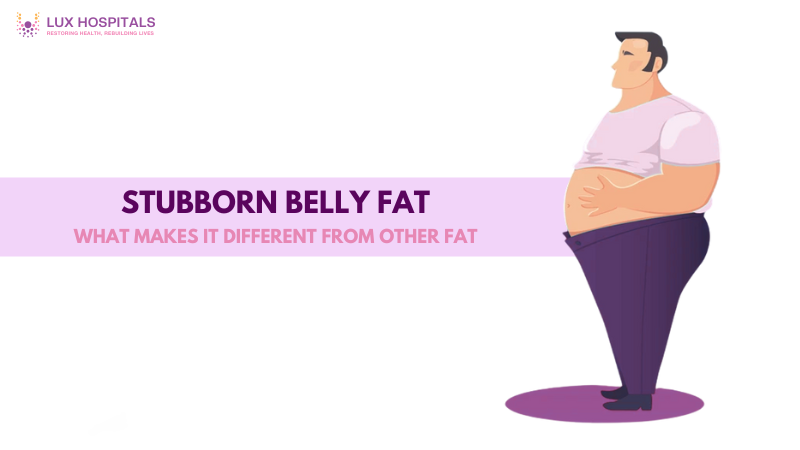Understanding Stubborn Belly Fat: Causes and Solutions

When it comes to weight loss, one of the most common struggles is shedding belly fat. While fat can build up in various areas of the body, the fat around your midsection tends to stick around longer than others. Many people find that belly fat is slow to respond, even with regular diet and exercise. Learning what makes belly fat different can empower you to tackle it with the right strategies and expectations. Understanding why belly fat behaves differently is the first step to overcoming it. Several elements, from hormonal imbalances to lifestyle factors like stress and sleep, make this fat harder to eliminate
What Is Belly Fat?
Belly fat is stored in the abdominal area. It includes subcutaneous fat (under the skin) and visceral fat (around the organs). While subcutaneous fat is visible and soft, visceral fat is hidden deep inside the belly. It wraps around vital organs like the liver and intestines. This deeper fat poses greater health risks, including insulin resistance and cardiovascular issues.
Why Belly Fat Is More Stubborn Than Other Fat?
Belly fat is notoriously difficult to lose due to its unique composition and how the body stores it. It has more beta-2 adrenergic receptors, which inhibit fat breakdown, making the area slower to respond to fat-burning signals. Additionally, fat cells in the belly are more insulin-resistant, holding onto fat even when you’re burning calories elsewhere. This makes abdominal fat more persistent than fat stored on the thighs or arms.
Hormonal Influence on Belly Fat
Hormones like cortisol, insulin, and estrogen directly affect the accumulation and retention of belly fat. Elevated cortisol levels, often due to chronic stress, signal your body to store fat in the abdominal area. High insulin levels from frequent sugar intake also promote fat storage. In women, declining estrogen levels after menopause often result in a shift from hip and thigh fat to belly fat, making hormonal balance crucial for fat management.
Genetics and Belly Fat Storage
Your genes largely dictate where your body prefers to store fat. For many people, that default location is the midsection. If your parents or siblings carry extra weight around their stomachs, you’re more likely to accumulate belly fat similarly. Additionally, your genetic makeup affects how your body responds to certain foods and how efficiently it burns fat, which can make fat loss a more personalized journey.
Age and Belly Fat Accumulation
Our metabolism slows, our muscular mass shrinks, and hormone levels shift—all contributing factors to belly fat accumulation. The loss of muscle reduces calorie-burning capacity, while hormonal changes, especially in middle age, favor storing fat around the belly. Older adults may notice they gain weight more easily around the abdomen, even if they haven’t changed their diet or activity level, making consistent lifestyle choices even more important.
Impact of Diet on Belly Fat
Poor dietary choices are one of the most significant contributors to belly fat. Excess calories from refined carbs, sugars, and trans fats get stored in the abdominal area. These foods also spike insulin, which encourages fat storage and increases cravings. Eating a fiber-rich diet, lean proteins, healthy fats, and whole foods can regulate insulin and support fat metabolism. Reducing portion sizes and avoiding processed snacks also helps shrink belly fat over time.
Exercise and Belly Fat: Why It Takes More
While exercise is key to fat loss, belly fat often requires a more targeted approach. Traditional cardio is helpful, but studies show that HIIT (High-Intensity Interval Training) and resistance training are more effective for trimming abdominal fat. These workouts boost your metabolism and burn calories even after the session ends. A well-balanced routine that includes both strength and cardio, performed consistently, is the best way to address belly fat long-term.
Sleep, Stress, and Belly Fat
Poor sleep and high stress levels can sabotage your fat loss goals, especially regarding belly fat. Sleep deprivation disrupts hormones like ghrelin and leptin, increasing hunger and cravings. Chronic stress elevates cortisol, which directly contributes to abdominal fat storage. Incorporating stress-reduction practices such as meditation, deep breathing, or yoga, and getting 7–9 hours of sleep per night can improve your ability to burn fat and regulate appetite.
Health Risks Linked to Belly Fat
Carrying excess belly fat increases your risk for numerous health conditions, especially if it’s visceral fat. This type of fat is linked to type 2 diabetes, hypertension, heart disease, stroke, and certain cancers. Unlike fat stored elsewhere, belly fat is inflammatory and negatively affects your body’s metabolic functions. Reducing it improves your appearance, longevity, and overall health profile.
Practical Strategies to Lose Belly Fat
To successfully lose belly fat, you need to address both lifestyle and physiological factors:
- Prioritize a clean, nutrient-rich diet low in sugar and processed foods
- Include strength training and HIIT workouts weekly
- Manage stress levels and improve sleep quality
- Stay consistent and monitor your progress over time
There is no magic solution for belly fat, but small, sustainable changes in multiple areas can lead to significant improvements over time.
Conclusion
More than just a cosmetic worry, belly fat is a serious health problem impacted by aging, stress, hormones, and heredity. Belly fat is more difficult to lose with food and exercise than fat in other body areas, so a multimodal strategy is required. You can gradually reduce stubborn belly fat by altering your diet, workout routine, stress management, and sleep habits. Time, consistency, and dedication to a healthier lifestyle are necessary for long-lasting lifestyle transformation.
Frequently Asked Questions
Belly fat is hormonally influenced and metabolically active, making it more resistant to fat-burning signals. It has more fat-retaining receptors than fat in other areas. Stress and insulin levels also play a key role in its persistence.
Unlike subcutaneous fat, belly fat includes visceral fat that surrounds internal organs and increases health risks. It's more metabolically harmful and inflamed. It also has a different hormone response than fat on the hips or thighs.
Spot reduction of belly fat is a myth, and ab-focused exercises won't remove it directly. Whole-body fat loss through HIIT, cardio, and weight training is more effective. These methods promote fat burning throughout the body, including the belly.
Losing belly fat depends on genetics, age, activity level, and diet. With consistent effort, visible changes may occur within 6 to 12 weeks. However, some may take longer due to hormonal or metabolic differences. Lifestyle consistency is key for lasting fat reduction.
Whole foods like leafy greens, lean proteins, avocados, and berries help reduce belly fat. These foods stabilize blood sugar and reduce inflammation. Avoid refined carbs, sugary snacks, and processed items that promote abdominal fat.




















